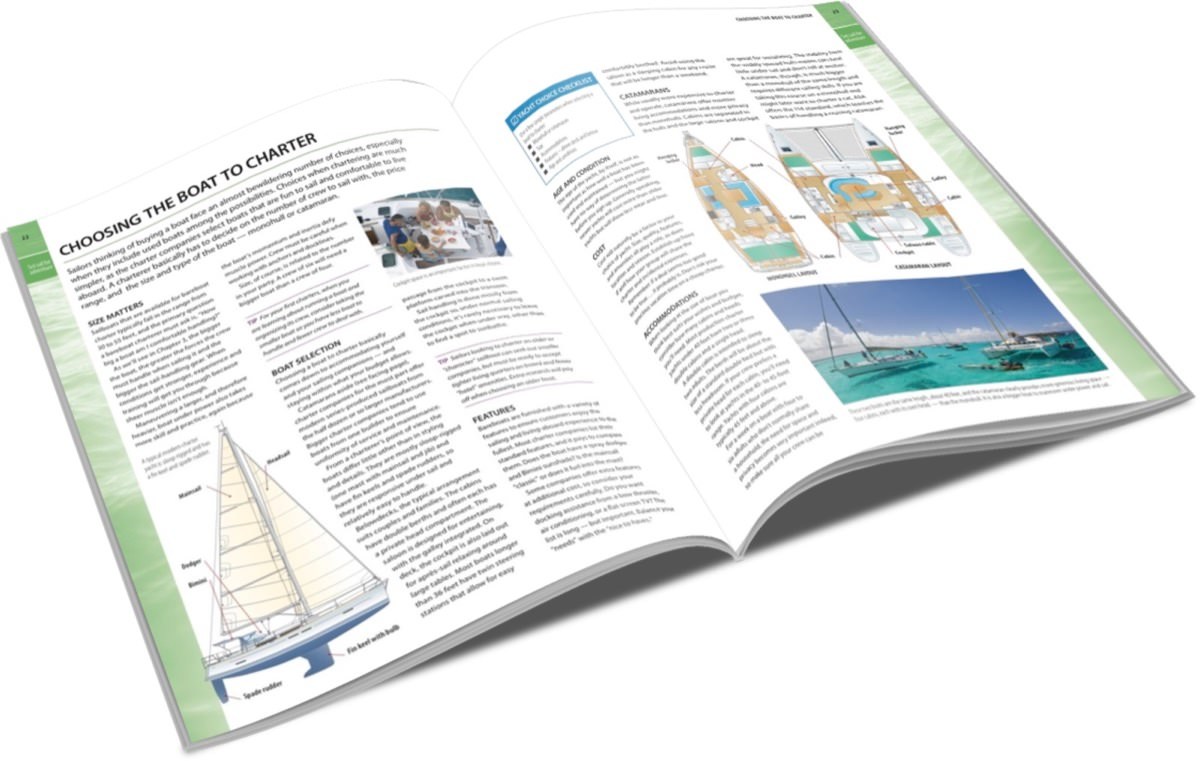When you complete ASA 104 Bareboat Cruising course, you will possess a wealth of knowledge about sailing, and you will have amassed a good deal of experience. Along with your ASA certification, you will be welcomed as a member of any crew, and you will feel more comfortable any time you are on a sailboat — or any boat.
With that said, it is good to be reminded of a few valuable tips from the ASA 104 Bareboat Cruising Course. Obtaining more experience is the precise way we all become better sailors. A seasoned sailor is often a more prepared sailor.
Here are some tips that may help on your next sailing journey.
On Bareboat Chartering
When you’re new to chartering or charter in an area that’s new to you, consider hiring a local skipper for the start of your charter (most companies make them available). It’s a great way to learn about the yacht and the locality at minimal cost and risk.
This may be the most valuable piece of advice that comes from the ASA 104 textbook. Sailing in unfamiliar waters and on a foreign boat can create anxiety and hamper your sailing holiday. Discuss skipper options with the charter company and start your bareboat charter with a captain. You’ll learn a lot about the destination and vessel you are chartering. One additional way to ease into chartering may be to join a flotilla where other sailors have experience in the area or on the same type of boat you’ll be chartering.

Your First Charter?
On a first charter, don’t try to take on all the sailing responsibility. Have at least one other capable sailor at your side, and be cautious about taking complete novices.
This tip is vital when sailing on your first bareboat charter. Do not take on all of the responsibility without an experienced first mate. Having another experienced sailor with you allows you to rely on another person when performing everything from picking up a mooring ball to preparing the dinghy for a ride to the dock.
Read the Charts
Study the nautical charts for your cruising area ahead of time. Plot out some navigable legs and distances to check whether your itinerary choices are realistic.
Familiarizing yourself with the sailing grounds allows for impromptu changes in the itinerary. Weather issues or a crowded anchorage are not a big deal if you are familiar with a backup plan and nearby options. Use the chart to help you plan your contingency plans long before you arrive at the destination. Find a local cruising guide to help add to your knowledge base if available.

Fresh Water Use
If you switch water tanks before the first one is empty, you’ll avoid running the pump dry, and you’ll have a little water in reserve.
This is key when you don’t have an idea of where you will be able to refill the freshwater tanks. The little bit of water in reserve is a lifesaver if you realize that a refill is a couple of days away and you are running way too low on tank number 2.
Conserve Power
Keep a close watch on your house battery charge levels. Prudent sailors don’t allow their batteries to go below 12.2 volts before recharging. Remember, the lower the voltage, the longer it takes to recharge the battery.
If anyone in your crew is new to living aboard a sailboat, take a few minutes to explain the connection between using electricity and the need to generate it. Remind them to turn off lights and fans when they leave their cabins and the head and to be selective when turning on lights and fans in the saloon and galley. A 24-watt bulb draws only 2 amps, but a dozen left on over the dinner hours make a big dent in your amp-hour account in your battery bank. When reading, instead of the cabin lights, use a flashlight or battery-powered headlamp to reduce power draw. Even if your charter boat has energy-efficient LED lighting, still be conservative with your use of battery power.

Time to Reef
Before you set sail, make sure that you know how to reef the mainsail.
Most charter companies will set the boat up with a reef in place. If that is the case, ask the person checking you in for a full rundown on how to add a second reef, and always ask the obvious questions so that you know exactly how everything works before you leave the dock and definitely before you need to reef.
It never hurts to say, “Please show me how to reef the mainsail.” Reefing is important.
Using Unfamiliar Equipment
Do not open a rope clutch that’s carrying a line under load. If it is released too fast, the loaded line will be sure to injure you. First, take three or four turns around a winch. Take up the load by grinding the winch, then open the clutch and carefully ease the line off the winch.
This is an important tip, especially if you are on a larger vessel than you are accustomed to. The loads on a 48-foot catamaran are significantly different than a 30-foot monohull.

Safety for the Crew
Most injuries on a boat are minor and are caused by tripping or falling. Advise your crew to use “one hand for yourself and one hand for the boat” to avoid accidental falls.
When on a bareboat charter, you will have a few individuals who are not as experienced, so it is always a good idea to reiterate some of the basic safety rules you learn in ASA 101. Safety should always be the number one priority from the moment you arrive at the dock until you check out and head back home.
Handling an Unfamiliar Boat
On any boat that‘s new to you, try losing the bow when under power to see how much room you need to recover control.
Sailboats tend to have more windage forward than aft, and the center of lateral resistance of the hull, keel, and rudder is usually well aft of the mast. Consequently, when a sailboat has no steerage, the wind blows its bow to one side. When this happens during a maneuver such as docking, it’s called “losing the bow.” Knowing how the boat will react and how quickly you can gain control is a valuable skill to have in your arsenal.
Slow it Down
Never be in a hurry when maneuvering out of or into a dock, but be ready to act quickly should you have to.
This is so important when on a bareboat charter. Be aware of possible problem areas when looking for an anchorage or when approaching an unfamiliar dock. It is much easier to recover from a miscalculation if you are going slow.

Dropping the Hook
If you’re not completely happy with your final resting position, move and re-anchor. You will not sleep easy if you worry about being too close to another boat. It’s better to move now than at 0200.
Any time you drop anchor, and you are responsible for the safety of your crew, you will worry about the placement of the hook. With that said, if your first attempt is not making you feel too confident, never hesitate to reposition in a spot that will hold better or keep you out of harm’s way. Learn how to anchor anywhere in the world.
Navigation
Don’t spend your sailing time staring at the GPS plotter. Refer to it if you want to confirm the results of using traditional navigation skills, but stay in the habit of looking around you. Nothing can replace “eyes on deck.”
In unfamiliar waters, always remember to be aware of those conditions that have changed since the charts were created. Also, ask the charter company about navigational hazards you should know.
Your ASA104 certification is your passport to the world’s finest cruising grounds and the foundation for a lifetime of further learning about the ways of boats and the sea. Your sailing career is just getting to the fun part; there is plenty of time and a nearly unlimited number of destinations to explore. Keep building your experience in a prudent manner to ensure your sailing adventures will be fun and safe.
Do you have a copy of Bareboat Cruising Made Easy?













